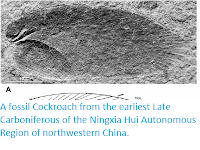Giant Cockroaches, Blaberidae, are generally large Cockroaches, reaching between 10 and 60 mm, with spines on their middle and rear legs. There are about 660 known species from across the globe, many of which give birth to live young.
In a paper published in the jounrnal Zoologia on 22 March 2018, Leonardo de Oliveira Cardoso da Silva and Sonia Maria Lopes of the Department of Entomology at the Museu Nacional of the Universidade Federal do Rio de Janeiro, describe six new species of Giant Cockroaches from Brazil, all of which are placed in the genus Poeciloderrhis.
The first new species described is named Poeciloderrhis aureolatus, in reference to their yellow-brown colour. The species is described from nineteen male and ten female specimens, collected in Rio de Janeiro and Minas Gerais states. The females are on average larger than the males, though the largest specimens of both sexes are about the same size, with females reaching 45.4-45.7 mm in length, compared to 41.6-45.7 mm in the males. These Cockroaches have triangular heads with black eyes and robust spines on all legs.
Poeciloderrhis aureolatus, male (top) and female (bottom). Scale bars 5.6 mm (top) and 6.0 mm (bottom). Silva & Lopes (2018).
The second new species is named Poeciloderrhis mediansclerostylatus, meaning 'stylus shaped median sclerite' in reference to a detail of the male genitalia. This species is described from a single male specimen collected in Rio de Janeiro State. This is 30 mm in length and shiny brown in colour, with a triangular head, dark brown eyes and strong spines on all legs.
Poeciloderrhis mediansclerostylatus, male specimen. Scale bar is 5.6 mm. Silva & Lopes (2018).
The third new species is named Poeciloderrhis diamantinensis, in reference to the municipality of Diamantino in Mato Grosso State, where this species was first discovered. The species is described from twelve male specimens from Mato Grosso, Rondônia and Goiás states. These range from 22.1 to 24.5 mm in length and are a shiny light brown colour with triangular heads, dark brown eyes, and strong spines on all legs.
Poeciloderrhis diamantinensis, male specimen. Scale bar is 3.4 mm. Silva & Lopes (2018).
The fourth new species is named Poeciloderrhis itatiaiensis, in reference to the Parque Nacional de Itatiaia, in Rio de Janeiro State, where the species was discovered. The species is described from a single male specimen, light brown in colour and 48.9 mm in length, with black eyes, a triangular head and spines on all legs.
Poeciloderrhis itatiaiensis, male specimen. Scale bar is 6.7 mm. Silva & Lopes (2018).
The fifth new species described is named Poeciloderrhis vanzolinii, in honour of herpetologist Paulo Emilio Vanzolini, who collected the specimen from which the species is described, a male from São Paulo State. This specimen is 27.5 mm in length, and shiny light brown in colour with dark brown eyes, a triangular head and strong spines on all legs.
Poeciloderrhis vanzolinii, male specimen. Scale bar is 3.5 mm. Silva & Lopes (2018).
The final new species described is named Poeciloderrhis penduloides, meaning 'pendulum shaped; in reference to the male genetalia. This species is described from a single male specimen collected in Rio de Janeiro State. This specimen is 26.9 mm in length and shiny light brown in colour, with brown eyes, a triangular head and spines on all limbs.
Poeciloderrhis penduloides, male specimen. Scale bar is 4.7 mm. Silva & Lopes (2018).
See also...
Follow Sciency Thoughts on Facebook.













